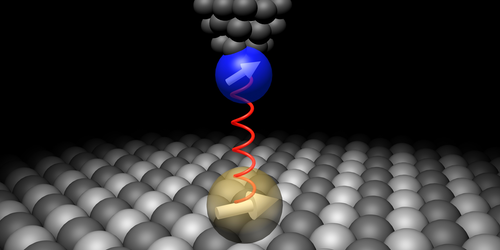Tuning an Atom’s Magnetic Field
Electronic devices continue to shrink as computer engineers squeeze ever more transistors and other components onto computing chips. Researchers have realized single-atom transistors, but single-atom data storage elements are still in their design phase. To become reality, researchers have to overcome obstacles such as devising methods to manipulate the magnetic field of an individual atom, an achievement that would allow atoms to be used for information storage. Kai Yang at the IBM Almaden Research Center in California and colleagues have now done exactly that, demonstrating a technique for tuning an atom’s magnetic field strength over 4 orders of magnitude. Yang says that their technique could be used to precisely adjust the magnetic properties of a variety of systems, including molecules and magnetic nanoparticles.
The team used an iron atom on the end of a scanning tunneling microscope (STM) tip to adjust the magnetic field of a titanium atom sitting on a surface. As the iron atom—which has a fixed magnetic field—neared the titanium atom, the titanium was subjected to a magnetic force, which caused its magnetic field to align with the iron’s. This force is similar to that between two fridge magnets brought into close proximity, and it is known as the “exchange interaction.” Through quantum effects, the exchange interaction also influenced the strength of the titanium atom’s magnetic field, with a stronger interaction leading to a stronger field. The team showed that they could increase the interaction strength by moving the STM tip closer to the titanium atom. While the technique could be used to write information in magnetic memory devices, Yang says that instead they plan to use it to study exotic quantum states in systems of magnetic atoms.
This research is published in Physical Review Letters.
–Katherine Wright
Katherine Wright is a Senior Editor of Physics.





